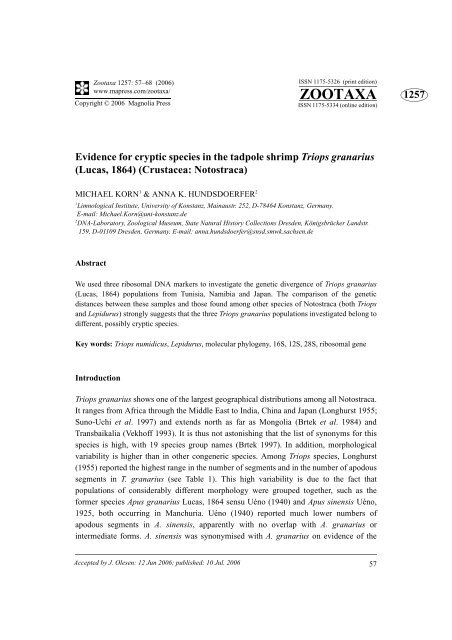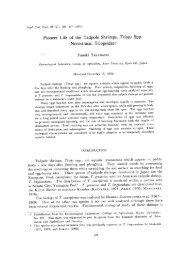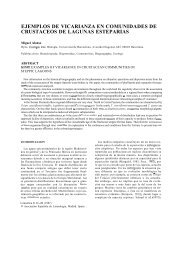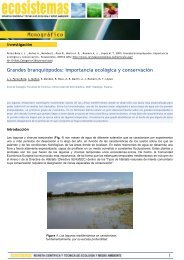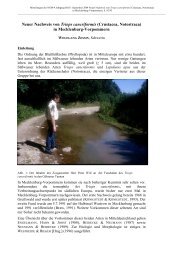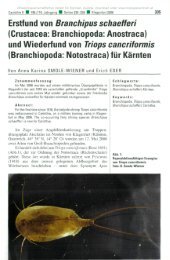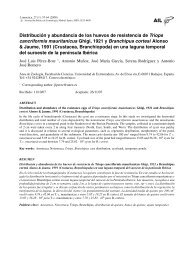Zootaxa, Triops granarius (Crustacea: Notostraca)
Zootaxa, Triops granarius (Crustacea: Notostraca)
Zootaxa, Triops granarius (Crustacea: Notostraca)
Create successful ePaper yourself
Turn your PDF publications into a flip-book with our unique Google optimized e-Paper software.
<strong>Zootaxa</strong> 1257: 57–68 (2006)www.mapress.com/zootaxa/Copyright © 2006 Magnolia PressISSN 1175-5326 (print edition)ZOOTAXAISSN 1175-5334 (online edition)1257Evidence for cryptic species in the tadpole shrimp <strong>Triops</strong> <strong>granarius</strong>(Lucas, 1864) (<strong>Crustacea</strong>: <strong>Notostraca</strong>)MICHAEL KORN 1 & ANNA K. HUNDSDOERFER 21Limnological Institute, University of Konstanz, Mainaustr. 252, D-78464 Konstanz, Germany.E-mail: Michael.Korn@uni-konstanz.de2DNA-Laboratory, Zoological Museum, State Natural History Collections Dresden, Königsbrücker Landstr.159, D-01109 Dresden, Germany. E-mail: anna.hundsdoerfer@snsd.smwk.sachsen.deAbstractWe used three ribosomal DNA markers to investigate the genetic divergence of <strong>Triops</strong> <strong>granarius</strong>(Lucas, 1864) populations from Tunisia, Namibia and Japan. The comparison of the geneticdistances between these samples and those found among other species of <strong>Notostraca</strong> (both <strong>Triops</strong>and Lepidurus) strongly suggests that the three <strong>Triops</strong> <strong>granarius</strong> populations investigated belong todifferent, possibly cryptic species.Key words: <strong>Triops</strong> numidicus, Lepidurus, molecular phylogeny, 16S, 12S, 28S, ribosomal geneIntroduction<strong>Triops</strong> <strong>granarius</strong> shows one of the largest geographical distributions among all <strong>Notostraca</strong>.It ranges from Africa through the Middle East to India, China and Japan (Longhurst 1955;Suno-Uchi et al. 1997) and extends north as far as Mongolia (Brtek et al. 1984) andTransbaikalia (Vekhoff 1993). It is thus not astonishing that the list of synonyms for thisspecies is high, with 19 species group names (Brtek 1997). In addition, morphologicalvariability is higher than in other congeneric species. Among <strong>Triops</strong> species, Longhurst(1955) reported the highest range in the number of segments and in the number of apodoussegments in T. <strong>granarius</strong> (see Table 1). This high variability is due to the fact thatpopulations of considerably different morphology were grouped together, such as theformer species Apus <strong>granarius</strong> Lucas, 1864 sensu Uéno (1940) and Apus sinensis Uéno,1925, both occurring in Manchuria. Uéno (1940) reported much lower numbers ofapodous segments in A. sinensis, apparently with no overlap with A. <strong>granarius</strong> orintermediate forms. A. sinensis was synonymised with A. <strong>granarius</strong> on evidence of theAccepted by J. Olesen: 12 Jun 2006; published: 10 Jul. 2006 57
ZOOTAXA original description, i.e., without reinvestigation of the type material (Longhurst 1955).1257 A careful reinvestigation of American <strong>Triops</strong> (Sassaman et al. 1997) demonstrated thatthe wide range of 5–12 apodous segments reported for females of <strong>Triops</strong> longicaudatus(LeConte, 1846) by Longhurst (1955) is misleading, as it actually gives the total range ofthree separate forms that overlap in the number of body and apodous segments. Althoughthese forms may not be separated from each other based on morphology alone, they arereproductively isolated (Sassaman et al. 1997). <strong>Triops</strong> longicaudatus sensu Longhurst(1955) was shown to comprise gonochoric (these have a high no. of apodous segments)and unisexual populations (with a low no. of apodous segments) of one species, andandrodioecious (i.e. consisting of hermaphrodites and males) as well as unisexualpopulations (both with an intermediate no. of apodous segments) of a second, crypticspecies (Sassaman et al. 1997). The variability of the character “number of apodoussegments” in gonochoric females of T. longicaudatus is thus comparatively low(SD=0.755, N=53, Table 5 in Sassaman et al. 1997), suggesting that this character mightbe of a higher discriminatory power in morphological classifications than suggested byLonghurst (1955). <strong>Triops</strong> <strong>granarius</strong> is reported to consist entirely of bisexual populations(e.g. Longhurst 1955), and there are no reports of nongonochoric reproduction in thisspecies. This is also true for populations with a low number of apodous segments, for anexample Japanese T. <strong>granarius</strong> (Akita 1976). The clear differences in the number ofapodous abdominal segments reported for different populations of T. <strong>granarius</strong> maytherefore also suggest the presence of cryptic species in T. <strong>granarius</strong>.TABLE 1. The number of body segments and the number of apodous segments (Total range;amount of difference, ∆, given in parentheses) in <strong>Triops</strong> species reported by Longhurst (1955).(∆No. of body segmentsNo. of apodous segmentsmale female Male female<strong>Triops</strong> cancriformis 32–35 (∆=4) 32–35 (∆=4) 5–9 (∆=5) 4–7 (∆=4)<strong>Triops</strong> australiensis 36–44 ( ∆=9) 35–43 (∆=9) 9–13 (∆=5) 5–12 (∆=8)<strong>Triops</strong> longicaudatus 35–44 ( ∆=10) 35–43 (∆=9) 10–13 =4) 5–12 (∆=8)<strong>Triops</strong> <strong>granarius</strong> 32–43 ( ∆=12) 32–42 (∆=11) 6–14 (∆=9) 4–13 (∆=10)Recent molecular investigations of American populations reported not only theoccurrence of cryptic species in <strong>Triops</strong> (Sassaman et al. 1997), but also in Lepidurus (King& Hanner 1998; Rogers 2001). Similarly, Mantovani et al. 2004 hypothesized the possibleoccurrence of a cryptic species in European Lepidurus [within Lepidurus apus (Linné,1758)]. In addition, <strong>Triops</strong> cancriformis (Bosc, 1801) [sensu Longhurst (1955)] has beenshown to consist of two separate species (Korn et al. 2006), giving further evidence thatLonghurst´s (1955) revision of the <strong>Notostraca</strong> may have been too restrictive, ratherdescribing species groups than species.58 © 2006 Magnolia PressKORN & HUNDSDOERFER
A reinvestigation of the phylogeny of all species sensu Longhurst (1955) is thusconsidered necessary. The present work may be regarded as the first step towards adetailed reinvestigation of T. <strong>granarius</strong>. It is the first study to investigate phylogeneticrelationships among populations of T. <strong>granarius</strong> from different continents, based onsequence data from mitochondrial and nuclear genes. The aim of the present study was toinvestigate the possible occurrence of cryptic or just unrecognized species in T. <strong>granarius</strong>.ZOOTAXA1257NoteIn the recent literature, two names have been applied to the species of <strong>Triops</strong> underinvestigation here: <strong>Triops</strong> <strong>granarius</strong> (Lucas, 1864), and <strong>Triops</strong> numidicus (Grube, 1865).In his review of the <strong>Notostraca</strong>, Longhurst (1955) synonymised the two species, treatingApus numidicus Grube, 1865 as a junior synonym, according to the publication dates.However, Brtek (1997) subsequently suggested that Apus <strong>granarius</strong> Lucas, 1864 was notdescribed before 1886 (Simon 1886) and that the synonymy thus should be inverted, withT. numidicus being the valid name for this species. We followed this latter interpretation inour last publication (Korn et al. 2006). In our present work, however, we carefullyinvestigated the original descriptions ourselves and came to the conclusion that the nameA. <strong>granarius</strong> was made available in a protocol of the short oral species description ofLucas given in a meeting of the “Societé Entomologique de France” in the “BulletinEntomologique” (later “Bulletin de la Societé Entomologique de France”) on 24 th February1864 (Lucas 1864). We thus conclude that <strong>Triops</strong> <strong>granarius</strong> (Lucas, 1864) is the validspecies name under the principle of priority.Material and methodsThe determination key given by Longhurst (1955) was used to determine specimens of<strong>Triops</strong> collected for the present study. We used both wild caught specimens and specimensraised in the laboratory from eggs in sediments. Samples were preserved in ethanol untilextraction. For total DNA extraction we followed a modified DTAB procedure(Gustincich et al. 1991). Fragments of the 12S and 16S ribosomal genes were amplifiedusing universal primers and PCR programs (details in Murugan et al. 2002). The 28Sfragment was amplified using the primers 28S_L1 (5’-AGCGGAGGAAAAGAAACTA-3’) and 28S_H4lv1 (5’-ACGATCGATTTGCACGTCAG-3’; taken from Sonnenberg et al.in prep.) and a standard PCR program with 30–40 cycles at an annealing temperature of60°C. For sequencing, the PCR products were sent to the DNA Sequencing Facility of theMax Planck Institute of Molecular Cell Biology and Genetics (Dresden, Germany). Theforward primers were used for direct sequencing of the PCR products, and if the sequencewas not of good quality, the reverse sequence was also obtained. We refrained fromsequencing both strands for all samples, since most sequences were of extraordinarilyTRIOPS GRANARIUS© 2006 Magnolia Press 59
ZOOTAXA1257good quality and we replicated the sequences by analysing 2–3 individuals per locality.The 12S alignment comprised 383 base positions, the 16S alignment of 474 and the 28Salignment of 955 base positions. The sequences have been submitted to GenBank underthe accession numbers AM269416-AM269423 (12S); AM269426-AM269433 (16S) andAM269437-AM269444 (28S) and will be made available to the public together withfurther sequences in a more detailed study of the North African populations of T.<strong>granarius</strong>. Tissue vouchers were deposited in the frozen tissue collection (part MTD-TW)of the “Museum für Tierkunde” of the State Natural History Collections in Dresden(Germany) under the numbers given in Table 2. Vouchers of the whole animals weredeposited in the <strong>Crustacea</strong>n collection of the same museum under the accession numbersMTD Crus 2667–MTD Crus 2674. As outgroups for the 28S sequence divergencecomparison we included one specimen of <strong>Triops</strong> longicaudatus sensu Longhurst (1955)(<strong>Triops</strong>, INC. commercial kit) and <strong>Triops</strong> cancriformis (commercial kit from Austria) each(vouchers MTD-TW 479 and 51 and accession numbers AM269435 and AM269436respectively).TABLE 2. The specimens of <strong>Triops</strong> <strong>granarius</strong> analysed in this study. The voucher number refers tothe tissue voucher in the frozen tissue collection (part MTD-TW) of the “Museum für Tierkunde”of the State Natural History Collections in Dresden, Germany.Voucher number Country of origin Locality107, 108 Namibia Aronedis86–88 Tunisia Pond 032, Hajib Al´Uyun41–43 Tunisia Pond 064, KairouanWe used 12S, 16S and 28S mitochondrial DNA sequences to compare geneticdistances (calculated with PAUP* v. 4.0b10; Swofford 1998) between <strong>Triops</strong> <strong>granarius</strong>populations from Tunisia and Namibia (localities in Table 2) and T. <strong>granarius</strong> from Japan(for Japanese populations only 12S and 16S sequence data were available). The sequencesof the latter were taken from the Genbank or extracted manually from Suno-Uchi et al.(1997). All other notostracan 12S and 16S sequences available in Genbank were includedin phylogenetic analyses to assess the relationships among them [except for fourLepidurus arcticus (Pallas, 1793) 12S sequences, as the relative position of the genefragment sequenced in these samples does not overlap sufficiently with that of the othertaxa so that too many N’s would have had to be inserted]. Lepidurus cryptus Rogers, 2001(12S sequences LCAJ0819, LCAJ0825, LCAJ0826 and LCAJ0829 databased with thetaxon name Lepidurus couesii Packard, 1875 in GenBank) was originally observed (butnot described) as a cryptic species within L. couesii by King & Hanner (1998), but hassince been described in detail as the new species Lepidurus cryptus Rogers, 2001 andshown actually to conform to the Lepidurus packardi Simon, 1886 morphotype by Rogers60 © 2006 Magnolia PressKORN & HUNDSDOERFER
(2001). Sequences of Leptestheria dahalacensis (Rüppell, 1837) were included asoutgroup in the phylogenetic analyses of the 12S and 16S gene fragments. The accessionnumbers of the sequences of L. dahalacensis, Lepidurus and <strong>Triops</strong> that were extractedfrom Genbank are presented as part of the taxon labels of the trees in Fig. 1. Taxon labelslacking accession or tissue voucher numbers indicate sequences from Suno-Uchi et al.(1997). The taxon sampling for the two genetic markers is very different due to thediffering availability of sequences. The 16S focuses on the relationships within <strong>Triops</strong>,whereas the 12S provides more information about the relationships within Lepidurus.Phylogenetic analyses were performed with PAUP*. We performed searches for eachgene separately with the optimality criterion maximum parsimony (MP; heuristic search;gaps treated as fifth base). Support for nodes was determined by bootstrapping with MP(hs settings nreps=1000, maxtrees=1000) and Neighbour Joining (NJ). The distances forthe NJ bootstraps were corrected by maximum likelihood, whereby the models ofsequence evolution (12S and 16S: TVM+G) were selected by hierarchical ratio testingwith the program Modeltest (v. 3.06; Posada & Crandall 1998).For a better interpretation of the sequence divergences found within <strong>Triops</strong> <strong>granarius</strong>,we assessed the overall range of intra-generic sequence divergence (12S and 16Ssequences) found among recognized species of <strong>Notostraca</strong>, i.e., genetic distances werecalculated for congeneric species pairs to determine what level of genetic differentiation isindicative of separation on species level. For the purposes of this study, Lepidurus a. apus(Linné, 1758) and L. a. lubbocki Brauer, 1873 are treated as separate species, becauseMantovani et al. (2004) indicated that genetic distances among these European taxa are ofthe same order of magnitude as those observed between recognized Lepidurus speciesfrom America and furthermore they do not form a monophyletic group (see also Tab. 3 andFig. 1).ZOOTAXA1257Results and discussionTwo reconstructions of the phylogenetic relationships within the <strong>Notostraca</strong> are presentedin Fig. 1. Fig. 1a represents one of the most parsimonious trees (phylogram) found in theanalysis based on the 12S data. Fig. 1b is based on the 16S data. Both trees indicate thatthe genera <strong>Triops</strong> and Lepidurus are monophyletic, although bootstrap support for themonophyly of <strong>Triops</strong> based on 12S sequences (Fig. 1a) is very low. Indeed, the monophylyof <strong>Triops</strong> has been questioned by several authors (e.g. Murugan et al. 2002 and Mantovaniet al. 2004), but this problem is not the focus of the present paper. The phylogeneticanalyses of both the 12S (Fig. 1a) and 16S (Fig. 1b) sequence data indicate three wellsupported clades among the populations of the species <strong>Triops</strong> <strong>granarius</strong>. The 16S data(Fig. 1b) even implies that the species is not monophyletic, but rather represents twoseparate lineages.TRIOPS GRANARIUS© 2006 Magnolia Press 61
ZOOTAXA1257to be continued (Fig. 1)62 © 2006 Magnolia PressKORN & HUNDSDOERFER
ZOOTAXA1257FIGURE 1. The phylogenetic relationships within the <strong>Notostraca</strong> as reconstructed from (a) 12S(one of 12 MP trees; tree length=350, CI=0.6200, RI=0.8811) and (b) 16S (one of 4 MP trees; treelength=321, CI=0.7539, RI=0.9345) gene sequences with maximum parsimony (heuristic searchwith the settings gapmode=new, add=cl). Branch lengths are proportional to genetic divergence.Numbers above (or to the left of) branches indicate bootstrap support calculated by maximumparsimony (settings as above and with maxtrees=1000, nreps=1000) to the left and (for anadditional comparison) calculated by NJ with ML-distances (nreps=1000) to the right of the "/".TRIOPS GRANARIUS© 2006 Magnolia Press 63
ZOOTAXA1257Table 3 (a–d) shows the magnitude of genetic distances within T. <strong>granarius</strong> comparedto interspecific distances between other congeneric species of both <strong>Triops</strong> and Lepidurus.For the 12S gene, genetic distances among species pairs range from 5.9 to 15.5% in <strong>Triops</strong>and from 4.5 to 12.4% in Lepidurus. For the 16S gene, the range in Lepidurus is from 2.6to 5.9% (Table 3c) and up to 9.0% in <strong>Triops</strong>. Unfortunately, no sequence data wereavailable for <strong>Triops</strong> newberryi (Packard, 1871) (assuming that the species names in theGenbank are correct), the sister species of T. longicaudatus (LeConte, 1846) (Sassamannet al. 1997), and no 16S sequences were available for <strong>Triops</strong> australiensis (Spencer &Hall, 1896). The latter represents the closest relative of the sister species T. longicaudatusand T. newberryi and thus the 16S distances among these three taxa are expected to bemuch lower than the values indicated in Table 3d. The high divergence of T. longicaudatusfrom Japan to the new world samples indicated by the 16S sequence data (Fig. 1b)deserves further study. Based on an interpretation of the Phylogenetic Species Conceptfavoring a strong breakdown into species, Murugan et al. (2002) suggested the existenceof six phylogenetic species within seven of the American populations studied. Followingan interpretation that allows for intraspecific variation (as does one of the most importanttraditional species concepts, the morphospecies concept), the data suggest that all samplesthey analysed may simply belong to a single species (compare to Fig. 1a). We foundprofound genetic divergence within T. <strong>granarius</strong>: the genetic distances between T.<strong>granarius</strong> from Japan and Africa are 11.0% in the 12S gene and 6.3% in the 16S gene, andbetween T. <strong>granarius</strong> from Tunisia and Namibia, we found genetic distances of 7.0% inthe 12S gene and 3.8% in the 16S gene. Thus, in contrast to the slight genetic variationfound by Murugan et al. (2002) within new world <strong>Triops</strong> (12S: max 1.6%; 16S: max0.4%), the divergence we detected within T. <strong>granarius</strong> is of the same magnitude as geneticdistances found between recognized species of <strong>Notostraca</strong>.Table 3e shows the genetic divergence of <strong>Triops</strong> species and the three African T.<strong>granarius</strong> populations studied, based on nuclear sequences (28S rDNA). The values aremuch lower than those observed in the mitochondrial DNA, but nuclear ribosomal genesare known to evolve more slowly than mitochondrial ribosomal genes (Hillis and Dixon1991). The value observed between the specimens of T. <strong>granarius</strong> from Namibia andTunisia (0.7%) was lower than those observed between T. cancriformis, T. longicaudatus,and T. <strong>granarius</strong> in pairwise comparisons (3.1–5.4%). This value (0.7%) is, however, notmuch lower than those observed between other species of Branchiopoda in this genefragment: two recognized species of the genus Parartemia (Parartemia contracta Linder,1941 AF209042 and Parartemia longicaudata Linder, 1941 AF209043; Anostraca) havealso only diverged by 0.9%. Although this value is slightly higher than that between thetwo African T. <strong>granarius</strong> populations studied in this paper, these two Parartemia speciesare not sister species (Remigio et al. 2002), indicating that values between recognizedsister species are probably lower. Furthermore, the different ecology of these crustaceansshould be taken into account: Parartemia are saltwater and T. <strong>granarius</strong> freshwatercrustaceans. It has been shown for Australian anostracans and daphniids that levels of64 © 2006 Magnolia PressKORN & HUNDSDOERFER
divergence in lineages from saline inland waters were substantially greater than levels ofdivergence in lineages occurring in freshwaters (Hebert et al. 2002; Remigio et al. 2001).This pattern may also hold for <strong>Notostraca</strong> (the populations we studied inhabit freshwaters).Several arguments thus suggest that the divergence of 0.7% between the two African T.<strong>granarius</strong> populations lies within the range typical for separation on species level.We conclude that our results indicate that <strong>Triops</strong> <strong>granarius</strong> comprises at least threeseparate cryptic species.ZOOTAXA1257TABLE 3. Genetic (p-) distances (in percent) between pairs of species, broken down by gene.Mean values are presented except for those marked with *, which indicate single values due tosingle comparisons of two sequences (i.e. no mean can be calculated). Due to differences inavailability of the gene sequences of the species not all comparative values could be calculated forboth genes. Lepidurus a. apus and L. a. lubbocki were treated as separate species (for details, seeMaterials and Methods section). a. 12S Lepidurus, b. 12S <strong>Triops</strong> (A.=Africa, N.=Namibia,Tu.=Tunisia, J.=Japan), c. 16S Lepidurus (the sequence from L. sp. AF209058 was excluded fromcomparisons), d. 16S <strong>Triops</strong> e. 28S <strong>Triops</strong>.a L.a.apus L.a.lubbocki L.arcticus L.bilobatus L.couesii L.cryptus L.lemmoniL.a lubbocki 6.6 - - - - - -L.arcticus 4.5 8.8* - - - - -L.bilobatus 6.4 9.7 8.2 - - - -L.couesii 8.0 10.7* 6.1* 9.4 - - -L.cryptus 8.0 11.2 9.3 6.4 12.4 - -L.lemmoni 4.7 7.9 6.4 4.9 8.9 6.7 -L.packardi 6.7 9.7 6.7 6.8 9.6 7.8 6.7b T. austr. T. cancrif. T. gran. A. T. gran. N. T. gran. Tu. T. gran. J.T. cancrif. 11.8 - - - - -T. gran. A. 10.9 15.3 - - - -T. gran. N. 10.3 15.5 n.a. - - -T. gran. Tu. 11.0 15.2 n.a. 7.0 - -T. gran. J. 8.2 12.2 11.0 10.3 11.3 -T. longic. 5.9 10.5 11.4 11.6 10.9 8.4c L.a.apus L.a.lubbocki L.arcticusL.a.lubbocki 5.2 - -L.arcticus 2.6* 5.6 -L.lemmoni 3.3* 5.9 3.1*to be continued.TRIOPS GRANARIUS© 2006 Magnolia Press 65
ZOOTAXA1257TABLE 3 (continued).d T. cancrif. T. gran. A. T. gran. N. T. gran. Tu. T. gran. J.T. gran. A. 8.5 - - - -T. gran. N. 8.6 n.a. - - -T. gran. Tu. 8.5 n.a. 3.8 - -T. gran. J. 8.7 6.3 6.0 6.3 -T. longic. 9.0 6.9 7.4 6.8 6.2e T. cancrif. T. gran. A. T. gran. N. T. gran. Tu.T. gran. A. 5.2 - - -T. gran. N. 5.4 n.a. - -T. gran. Tu. 5.2 n.a. 0.7 -T. longic. 3.6* 3.2 3.3 3.1<strong>Notostraca</strong>n species often do not show clear morphological differentiation which, foran example, has resulted in the classification of Lepidurus packardi and L. couesii as twosubspecies of L. apus by Longhurst (1955). Small but consistent morphologicaldifferences suggest a possible differentiation at the species level. Thus, literature data givenumerous indications on the possible occurrence of further distinct species in T. <strong>granarius</strong>even within rather small geographic areas. For example, Thiéry (1996) reported twodifferent morphotypes within the Arabian Peninsular. Similar results have been reportedfor Moroccan (Thiéry 1987), Indian (Tiwari 1951), Southern African (Barnard 1929) andNorthern Chinese (Uéno 1940) populations; for Southern Africa, India and NorthernChina, several species of <strong>Triops</strong> have even been described on the basis of minormorphological differences. These were later regarded as synonyms of T. <strong>granarius</strong> byLonghurst (1955). Future surveys should therefore examine genetic distances amongpopulations of T. <strong>granarius</strong> on a fine geographical scale within its total range and comparethem to morphological characters and ecological traits, to investigate the potential numberof cryptic or presently unrecognized species within this taxon.AcknowledgementsWe are very thankful to Federico Marrone (University of Palermo) and Thorid Zierold(University of Freiberg and University of Hull) for providing samples for thisinvestigation and we are greatly indebted to Anke Müller and Christian Kehlmaier (bothMuseum für Tierkunde/Zoological Museum Dresden) for their engagement in sequencingwork. Arne Nolte (Köln) generously provided 28S primer sequences. We are also verythankful to Margarida Machado (Universidade do Algarve) for advice on taxomomicliterature and Ian J. Kitching (Natural History Museum, London) as well as Christian66 © 2006 Magnolia PressKORN & HUNDSDOERFER
Kehlmaier for valuable suggestions on its interpretation. Ian J. Kitching’s help withformulating some difficult phrases is greatly acknowledged. We would further like tothank four anonymous reviewers for their most helpful suggestions that greatly improvedthe manuscript. We are grateful to the librarians of the library “UniversitätsbibliothekJohann Christian Senckenberg” in Frankfurt, Germany for finding the protocol of Lucas’oral description of Apus <strong>granarius</strong> given 1864 in the “Bulletin Entomologique” withoutavailability of the exact reference.ZOOTAXA1257ReferencesAkita, M. (1976) Classification of Japanese tadpole shrimps. Zoological Magazine, 85, 237–247.Barnard, K.H. (1929) A revision of the South African Branchiopoda Phyllopoda. Annals of theSouth African Museum, 29, 181–272.Brtek, J. (1984) Contributions to the knowledge of the Branchiopoda (<strong>Crustacea</strong>) fauna of Mongolia.Annales Historico-Naturales Musei Nationalis Hungarici, 76, 91–99.Brtek, J. (1997) Checklist of the valid and invalid names of the “large branchiopods” (Anostraca,<strong>Notostraca</strong>, Spinicaudata and Laevicaudata), with a survey of the taxonomy of all Branchiopoda.Zborník Slovenského národného Múzea Prírodné Vedy, XLIII, 3–66.Gustincich, S., Manfioletti, G., Del Sal, G., Schneider, C. & Carninci, P. (1991) A fast method forhigh-quality genomic DNA extraction from whole human blood. Biotechniques, 11, 298–301.Hebert, P.D.N., Remigio, E.A., Colbourne, J.K., Taylor, D.J. & Wilson, C.C. (2002) Acceleratedmolecular evolution in halophilic <strong>Crustacea</strong>. Evolution, 56, 909–926.Hillis, D.M. & Dixon, M.T. (1991) Ribosomal DNA: Molecular evolution and phylogenetic inference.The Quarterly Review of Biology, 66, 411–453.Korn, M., Marrone, F., Pérez-Bote, J.L., Machado, M., Cristo, M., Cancela da Fonseca, L. &Hundsdoerfer, A. K. (in press) Sister species within the <strong>Triops</strong> cancriformis lineage (<strong>Crustacea</strong>,<strong>Notostraca</strong>). Zoologica Scripta, 35, pp. 301–322.King, J.L. & Hanner, R. (1998) Cryptic species in a ´´Living Fossil´´ lineage: Taxonomic and phylogeneticrelationships within the genus Lepidurus (<strong>Crustacea</strong>: <strong>Notostraca</strong>) in North America.Molecular Phylogenetics and Evolution, 10, 23–36.Longhurst, A.R. (1955) A review of the <strong>Notostraca</strong>. Bulletin of the British Museum (Natural History)Zoology, 3, 1–57.Lucas, H. (1864) Séance du 24 Février 1864. Communications. Bulletin Entomologique, Séancesde l’année 1864, XI–XII.Mantovani, B., Cesari, M. & Scanabissi, F. (2004) Molecular taxonomy and phylogeny of the ´livingfossil´ lineages <strong>Triops</strong> and Lepidurus (Branchiopoda: <strong>Notostraca</strong>). Zoologica Scripta, 33,367–374.Murugan, G., Maeda-Martínez, M., Obregón-Barboza, H. & Hernández-Saavedra, N.Y. (2002)Molecular characterization of the tadpole shrimp <strong>Triops</strong> (Branchiopoda : <strong>Notostraca</strong>) from theBaja California Peninsula, México: New insights on species diversity and phylogeny of thegenus. Hydrobiologia, 486, 101–113.Posada, D. & Crandall, K.A. (1998) Modeltest: testing the model of DNA substitution. Bioinformatics,14, 817–818.Remigio, E.A., Hebert, P.D.N. & Savage, A. (2001) Phylogenetic relationships and remarkableradiation in Parartemia (<strong>Crustacea</strong>: Anostraca), the endemic brine shrimp of Australia: evidencefrom mitochondrial DNA sequences. Biological Journal of the Linnean Society, 74,59–71.Rogers, D.C. (2001) Revision of the Nearctic Lepidurus (<strong>Notostraca</strong>). Journal of <strong>Crustacea</strong>n Biol-TRIOPS GRANARIUS© 2006 Magnolia Press 67
1257ZOOTAXA ogy, 21, 991–1006.Sassaman, C., Simovich, M. A. & Fugate, M. (1997) Reproductive isolation and genetic differentiationin North American species of <strong>Triops</strong> (<strong>Crustacea</strong>: Branchiopoda: <strong>Notostraca</strong>). Hydrobiologia,359, 125–147.Simon, E. (1886) Étude sur les Crustacés du sous-ordre des Phyllopodes. Annales de la Sociétéentomologique de France, 6, 393–460.Suno-Uchi, N., Sasaki, F., Chiba, S. & Kawata, M. (1997) Morphological stasis and phylogeneticrelationships in tadpole shrimps, <strong>Triops</strong> (<strong>Crustacea</strong>: <strong>Notostraca</strong>). Biological Journal of the LinneanSociety, 61, 439–457.Swofford, D.L. (1998) PAUP*—Phylogenetic Analysis Using Parsimony (*and other methods).Ver. 4.0b10. [Computer software]. Sinauer Associates, Sunderland, Massachusetts.Thiéry, A. (1987) Les Crustacés Branchiopodes Anostraca <strong>Notostraca</strong> & Conchostraca des milieuxlimniques temporaires (Dayas) au Maroc. Taxonomie, Biogéographie, Ecologie. Thèse Doctoratd´Etat des Sciences, Université Aix-Marseille III, 405 pp.Thiéry, A. (1996) Large branchiopods (<strong>Crustacea</strong>: Anostraca, <strong>Notostraca</strong>, Spinicaudata, Laevicaudata)from temporary inland waters of the Arabian Peninsula. In: Krupp, F. & Mahnert, V. (Eds.), Fauna of Saudi Arabia 15. National Commission for Wildlife Conservation and Development,Riyadh, Saudi Arabia; Pro Entomologica c/o Natural History Museum, Basle, pp. 37–98.Tiwari, K.K. (1951) Indian species of the genus Apus (<strong>Crustacea</strong> Branchiopoda) with description oftwo new species. Records of the Indian Museum, XLIX, 197–205.Uéno, M. (1940) Phyllopod <strong>Crustacea</strong> of Manchoukuo. Bulletin of the Biogeographical Society ofJapan, 5, 87–102.Vekhoff, N.V. (1993) The fauna and zoogeography of fairy and tadpole shrimps of Russia and adjacentlands (<strong>Crustacea</strong> Anostraca, <strong>Notostraca</strong>). Arthropoda Selecta, 2, 11–42.68 © 2006 Magnolia PressKORN & HUNDSDOERFER


